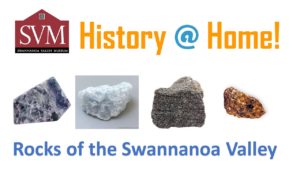
There are many different kinds of rocks that can be found throughout the Swannanoa Valley. These rocks represent the history of how the Swannanoa Valley was formed over the centuries. When you drive to lake Tomahawk or look up at the seven sisters you may notice the many folds that form our Valley. Buncombe County sits in the center of a fold and thrust belt known as the “Blue Ridge Thrust Complex”. This means the group of rocks in our area represent the result of millions of years of compression and collision between continental plates. A fold and thrust belt is a series of foothills and mountains that develop from extensive folding as rocks compress and thrust on top of each other as compression persists. The Blue Ridge Thrust Complex records a complex history of mountain building throughout hundreds of millions of years. All of this activity forms rocks and minerals that can be commonly found on the ground in our valley. These rocks can be classified as igneous, metamorphic, and sedimentary.
Vocabulary Words
Igneous rocks: Form when magma, or melted rock from inside the Earth, cools and hardens. They can form above ground when magma erupts from a volcano as lava. They can also form deep inside the Earth’s crust and then be exposed at the surface by the overlying rocks wearing away. The crystals found in igneous rocks have angular shapes. They have not been worn like sedimentary rocks or squished like metamorphic rocks.
Sedimentary Rock: The next time you’re at the Swannanoa River, grab a handful of sand. This material is sediment. Sediment carried by water and wind is deposited in layers. When sediment becomes cemented together it forms sedimentary rocks. These rocks are the best places to search for fossils.
Metamorphic Rock: Deep inside the Earth, intense heat and pressure can change rocks into entirely new metamorphic rocks. The conditions are so extreme, they can change the rock’s texture, color, and the shape of its crystals. Even the rocks minerals are broken down and new ones are formed. This can happen to any rock igneous, sedimentary, even other metamorphic rocks.
Sample of Rocks and Minerals Found in the Valley
Calcite: A Carbonate mineral. It is the most common form of natural calcium
carbonate. It is abundant in North Carolina and is mined in quarries across the state
Fluorite: Also called Fluorspar, it is the mineral form of calcium fluorite. It is a widely
occurring minerals that can be found across the globe. In North Carolina, Fluorite can be found in several areas of the state, although it is most common in WNC.
Amphibolite:is a coarse-grained metamorphic rock that is composed mainly of green, brown, or black amphibole minerals and plagioclase feldspar.
Rhodolite: Pink variety of garnet unique in North America to North Carolina. Pale pink rhodolite was reported in Asheville in 1893 and discovered in 1895 during mining for ruby corundum in the Cowee Valley. A mixture of 2/3 pyrope garnet to 1/3 almandine garnet, it was named for its color’s resemblance to the blooms of rhododendron.
Edible Rock Cycle Activity
This activity illustrates the different steps of the rock cycle. Using candy,
you can demonstrate how rocks change and how they are shaped and
formed while moving through the rock cycle.
Materials
Starbursts (or AirHeads)
Ziplock baggies
Scissors (make sure they are thoroughly washed!)
PAM
Wax Paper
Microwave
Microwave Safe
Plate
Directions
1. Pick out 4-5 different colored Starbursts (unwrapped).
2. To create weathered “sediment,” use the scissors to cut the Starbursts into
smaller pieces. Add the pieces to a Ziplock baggie and seal.
3. With the Starburst pieces in the baggie, students can squish the different
sediments together, mixing the colors. This demonstrates compaction and
cementation of sediments to become sedimentary rocks.
4. Students should then remove their sedimentary Starburst rock from the bag and
shape it with their hands, stretching and folding it. By applying heat and
pressure, their sedimentary rock has now become a metamorphic rock.
5. The next step can be completed one of two ways:
Place a sheet of wax paper (and spray with PAM, if desired) on a
microwave safe plate. Microwave each Starburst rock for about 5 seconds.
6. The heat of the microwave represents magma,which melts an existing rock. Once cooled, it is an igneous rock.
Tips and Tricks
1.Once you complete the final step, you can repeat the entire activity with
your students to demonstrate that rocks are always moving through the
rock cycle.
2. When melting the Starburst rocks in “magma,” add popsicle sticks to make
the rocks easier to eat.
3.When creating sedimentary rocks, add other candy, such as Nerds, for
additional sediment.